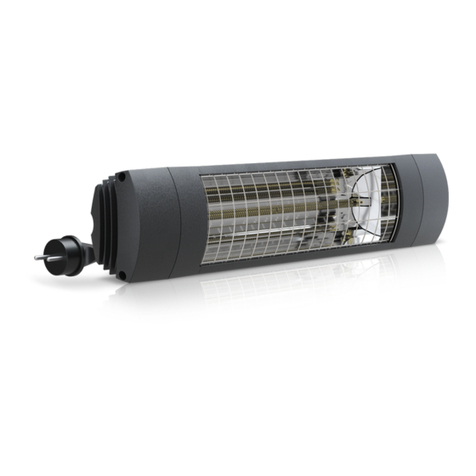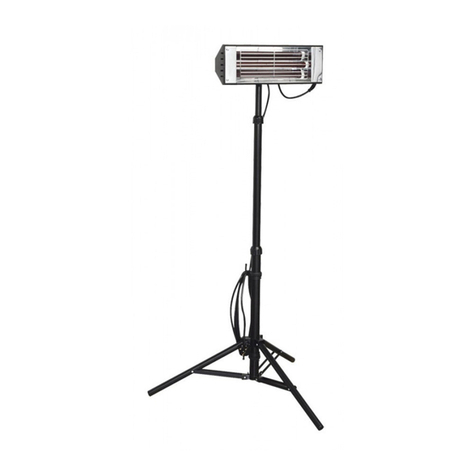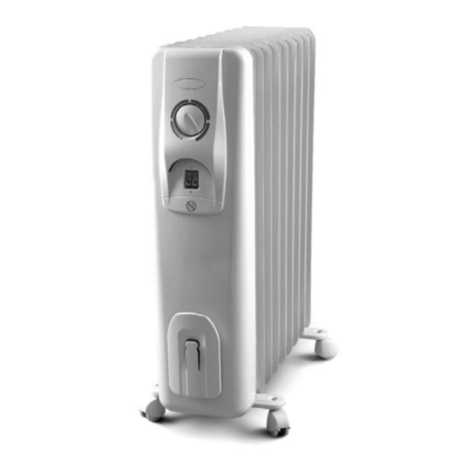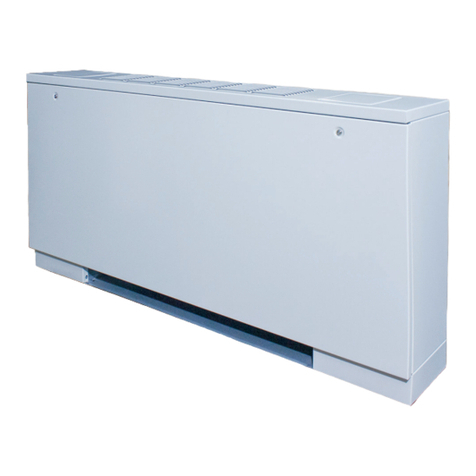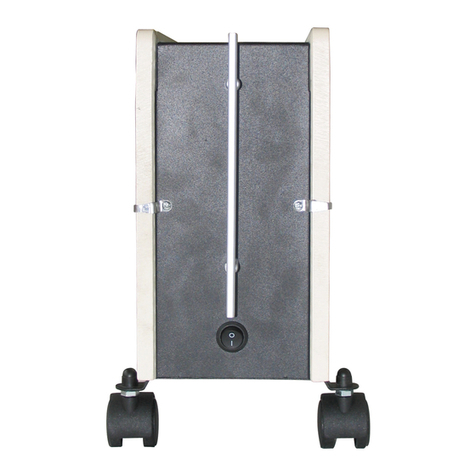Gaz Industrie BTwin BTH25 Owner's manual

Radiant Tube Heaters
BTwin BTH25
French Model
II 2Er3+ Category
TECHNICAL INST UCTIONS FO
INSTALLATION – MAINTENANCE & USE
10.10.919 /J
04/2014
TM
Warning
Please read this document carefully before commencing the installation and leave it with the user after
installation. The document accompanying each unit is meant for the installer and the user. This document
contains instructions for installing the heater and flue system and describes in particular how to carry out gas
connection & electrical connection. Subcontractors must also receive this document.

- 2 -

- 3 -
INDEX
1 ULES
P 4
2 TECHNICAL SPECIFICATIONS
P 5
3 DIMENSIONS
P 6
4 APPLIANCE ASSEMBLY
P 7
a/ Packaging
b/ Unit assembly
5 HANGING AND FIXING THE UNIT P 9
6 CLEA ANCES
P 11
a/ istances to unprotected combustible materials
b/ Minimum recommended mounting height
7 EVACUATION OF COMBUSTION P ODUCTS
P 12
Type A
Type B
Type C
8 INSTALLATION METHOD & CONNECTIONS
P 17
a/ Electrical connection
b/ Flue system
c/ Gas connections
d/ Option ‘Failure signal transmission’
9 TEMPE ATU E EGULATION
P 18
10 P OG AMMING
P 19
11 SETTING UP
P 19
12 MAINTENANCE
P 19
13 GAS CHANGE
P 21
14 FAULTS – POSSIBLE CAUSES - SOLUTIONS
P 22
15 ELECT ICAL SCHEMA P 23
16 OPTIONS ON EQUEST P 24
17 PA TS LIST
P 24
18 LIST OF OFFICIAL TEXTS
P 25

- 4 -
1 ules
GENE AL CAUTION
• The installation will have to be in compliance with the norms in force and be carried out
according to traditional rules by a skilled worker..
• The installer will have to refer to the various existing official documents according to the
different stages that the installation will require (see enclosure 1 at the end of this
document).
• The radiant tubes are CE certified and approved for use in many countries. In order to
meet the national requirements only appropriate models should be used (in case of
doubt, please contact us). The guarantee of conformity to regulations and standards
does not apply to units designed for the French market but installed in foreign countries.
• The hotpoint of the heater amounts to more than 150°C. Please follow the directives of
the competent authorities and respect the rules in force related to classified buildings or
risky sites.
• The use is also prohibited in all the premises where there are corrosive fumes, even if
there are small quantities of them, whose combination with water vapour and/or
combustion products will entail abnormal deteriorations of the appliances. For example :
chlorinated, sulphurous, ammonia or sodium products and diverse acid products
• All the requirements of the present regulation concerning ventilation and purifying shall
be respected.
GUA ANTEE LIMITS
Warranty is void if following instructions are not respected:
• The heaters are only designed for use in non domestic applications with exclusion of any
other utilization.
• Heaters must be installed inside the room, protected against humidity and bad weather
conditions.
• Heaters must not be installed in atmospheres containing aggressive or corrosive
vapours, even in small concentrations as the combination with combustion products can
deteriorate the material (e.g. : chloride, sulphurous, ammonium, sodium and all kind of
acid products)
• Storage of heater must be done carefully avoiding shocks and ensuring that heater is
protected against bad weather conditions.
• The installation must be in accordance with these instructions
• Modification to this appliance is not authorized

- -
2 Technical specifications
Model BTH25
Nominal heat input kW HI 25
Combustion efficiency % 90
Radiation factor 0,57
NOX class 4
Electrical connexion 230/240V 50Hz single phase
Fuse protection 1 fusible 5A
Starting electrical power VA 120
Functioning electrical power VA 70
Combustion air & venting A2, B22, C12, C32
Combustion air inlet opening type A & B mm Ø43
Combustion air inlet opening type C mm Ø40
Flue outlet diaphragm diameter - nihil
Air pressure switch adjustment Pa 49
Turbine discharge mm Ø133
Weight kg 72
Adjustments in function of gaz
Distributed gas 2H, 2E 2L, 2E 3P 3B
Gas category for France II2Er3+ x x x x
Gas reference G20 G25 G31 G30
Heat input (Hi) of gas reference
1013mbar
10référence1013 mbar 15°C
34,02MJ/m3
29,25MJ/m3
46,34MJ/kg 45,65MJ/k
g
Nom. Inlet pressure mbar 20 25 37 29
Min. inlet pressure min mbar 17 20 25 20
Max. inlet pressure max mbar 25 30 45 35
BTH25 Ø injector mm x 100 450 450 260 260
Pressure by injector mbar 8,5 13,5 RB* RB*
Gas flow 15°c 1013mbar 2,65 m3/h 3,08 m3/h 1,94 kg/h 1,97 kg/h
*
RB = blocked regulator

- 6 -
3 Dimensions
Combustion air inlet opening
Flue pipe outlet opening

- 7 -
4 Appliance assembly
a/ Packaging
Qty Désignation éférence
1 Carton containing burner
2 Tubes Ø76,1 – lg : 4 400mm 1030001
2 Reflector –lg : 2 515mm 1003451
2 Turbulator tube Ø76,1 – lg : 2m 1003110
b/ Appliance assembly
The 2 long tubes (A) are identical with no special way of assembly.
Install the tubes in the fastening rings (C) fixed on the traverses (B).
Pay attention to the direction of the traverses (B).
Ensure that fixing holes are always in the bend direction.
Put the turbulators ( ) inside the tubes.
- Tube extractor side
Provide each extremity with the 2m length
turbulators( ).
A
A
B
B
B
C

- 8 -
Assembly the bend (E) on the tubes Make certain that the screw (A2) goes through the
elongated hole (A1) in the tube ensuring so that the moving burner bend come to a standstill !!
Assembly the burner block (F) on the tubes. Make certain that the screw (A2) goes through
the elongated hole (A1) in the tube ensuring so that the moving burner block will come to a
standstill !!
Attention : Take off the plastic protection of the reflectors (G).
Put the fixing brackets of the reflectors (H) in open position.
Place the reflector (G) with the rectangular nick at the Ubend side into the brackets grooves.
- Put the fixing brackets of the reflectors (H) in closed position by blocking the screw for
maintaining the reflectors in place.
Inclination 40mm ±10
The total gradient of the heater must be 40 mm ±10 in the direction of the Ubend
E
F
G
H
G
G
A1
A
2

- 9 -
Top view, installed unit
5-Suspension/Fixing
Suspend the radiant tubes by means of chains or cables of adequate length fixed to
framework, under shores or portals, between pillars or against a wall. Optional fixing parts can
be supplied by GAZ IN USTRIE.
ATTENTION : For a good system efficiency, do not incline the unit up to 30°!!
Kit composition :
Model Horizontal hanging Wall hanging
Reference of the kit Reference of the kit
BTH25 0340131 0340119
HORIZONTAL HANGING WALL HANGING
Burner side
Extractor side
F
E
G
B
A
C
3 fixing holes Ø 11

- 10 -
SAFETY INST UCTIONS
Care must be taken to install the anchor points perpendicular to the end supports
.
The model BTH25 contains 3 points of anchorage
Inclination 40mm ±10
The total gradient of the heater must be 40 mm ±10 in the direction of the Ubend
Very important:
Make use of a flexible suspension system enabling the expansion of the emitter tubes but
avoiding extreme oscillations.
Wall supports, supplied on request by GAZ IN USTRIE take this instruction into account.
Mark Designation
A Required anchor points
Wrong Wrong
Good

- 11 -
6 Clearances
a/ Minimum distances towards unprotected combustible materials
Units must be installed so that the minimum
clearances towards unprotected combustible
materials are maintained.
Furthermore, a thermal insulation is to be installed
between the hanging support of the appliance and
the material on which it is fixed, in case this material
should be of a flammable nature.
CA EFUL : efer to the rules in force.
b/ ecommended minimum height
The minimal recommended mounting height in
relation to the ground and in the case of global
heating of a closed building if:
Heights and mounting positions depend of the
building structure and of the study implantation.
PA TICULA CASES :
1)
uring the installation of an appliance above an overhead crane, provide if necessary
the protection of the crab’s motor and of electrical equipments by the means of an
insulating sheet.
2)
Avoid the installation of radiant tubes above bulky machines or stores which could
prevent the diffusion of radiation towards the workers or users.
3)
In the presence of lifting ramps (vehicle repair workshops) care should be taken not to
fit the radiant tubes directly above these ramps. In fact, deterioration may occur to cars
with bodies or covers which could stay on the high position of the ramp.
4)
In the case of a workshop including pits or hidden zones, we cannot guarantee in
these zones the same conditions of comfort as in the rest of premises.
Device Horizontal
hanging
Wall hanging
BTH25 4,10 m 3,50 m
Combustible
materials
Combustible
materials

- 12 -
7 Evacuation of combustion products
According to the type of building, to the insulation or to the air tightness of the building, there
are 3 possible solutions:
Type A - Throwing out of the combustion products into the atmosphere
Type B - Individual fluting of each unit outside the building.
Type B - Appliances connected to a flue manifold system.
Type C - Balanced flue system, combustive air and combustion products taken/thrown from/to
the outside( by concentric air hole or separated pipes).
The following indications about the air renewal concern the good functioning of the
appliances. o not forget also to take into account the rules concerning people leaving in the
heated premises
TYPE A
THROWING OUT OF THE COMBUSTION PRO UCTS INTO THE ATMOSPHERE
GAZ IN USTRIE radiant tubes have a good combustion hygiene which has been controlled
for the CE mark. However, they can only be installed and used in well ventilated premises .
Radiant tubes can be installed without evacuation ducts for the combustion products within
the limits of the regulations in force. In that case, no modification has to be brought to the
units which are already equipped with a protection grille.
Attention : In public buildings, the evacuation of flue gases is obligatory.!!
* However we draw your attention to the fact that combustion products emitted into the
atmosphere can perceptibly modify the humidity level depending on the air change rate of the
building.
In case products of combustion are not evacuated outdoors, ensure that the location where
the unit is installed provides sufficient air to ensure a good functioning of the unit and the
dilution of the combustion products by 10 m
3
/h per kW installed.
o not allow combustion products to come into contact with combustible materials.
CA EFUL : refer to the rules in force.
TYPE A
TYPE B
TYPE C

- 13 -
TYPE B
a / IN IVI UAL FLUTING OF EACH UNIT OUTSI E THE BUIL ING
- Remove grill at exhaust pipe (1).
- And replace with connection piece Ø100 (2) for Ø97 tube.
- o not use grill as protection for a flue pipe end.
- Air inlets must be sufficient in the premises in order to
allow a good supply of the burner with air of combustion
Plan for an external air flow of at least 1,75 m3/h per
installed kW.
SAFETY INST UCTIONS CONCE NING THE INDIVIDUAL EVACUATION DUCT :
- No reduction of diameter can be accepted after the connection piece.
- It must be made out of stainless steel or aluminium with smooth and rigid duct.
- The evacuation must be realized according to the norms in force in each concerned country.
- The maximum lenght of the exaust pipe do not be up than 8 meters + 3 bends 90° + 1
terminal ( see on the spreadsheet herunder).
- The duct must not include low point.
- Any accessory made out of plastic or PVC is absolutely prohibited.
Air flow Fumes
temperature
Volumic flow Massic flow
BTH25 44 m
3
/h 177 °C 76 m/
3
h 57 kg/h
Flue system pipe lengths
Elbow 90° 2 m
Ebow 45° 1 m
Std protection cap against rain 2 m
1m rigid hose 1 m
CA EFUL : refer to the rules in force.
1
2

- 14 -
b / APPLIANCES CONNECTE TO A FLUE MANIFOL SYSTEM
Very important :
The flow extracted on each appliance must be equivalent.
The installer will have to comply with the official texts of each country concerning mechanical
evacuation and will have to get information from the competent national organisations about :
1) how to balance the network.
2) the controls and the different securities to put into operation.
Schematic diagram
It is necessary to take off the grille of flue outlet from the appliances and to replace it by a
connection piece. Connect the top of the dilution piece to the collector with a flue tube and
check that the connection of this duct is made on the side of the main duct (collector) and not
from below. Place the dilution piece on the tube coming from the appliance and fix the 3 fixing
parts by the means of screws or rivets.
o not take off the screwed rod which is used as a thrust.
Plan for that the air entry in the building is a minimum of
10m3/h per kW.
Details for the connection on collector
N° esignation
1 Collector
2 Slope 4mm/m
3 Security pressure switch
4 Extraction fan
5 Condensation collector
Extracted flow
dilution included
BTH25 250 m
3
/h
N°
Designation
1 Connection piece BTwin
2 Evacuating pipe Ø97
3 3 fixing parts at 120°
4 ilution piece (Option supplied by GAZ
IN USTRIE. on request)
5 Pipe Ø125 mini of collector
6 ( iaphragm or equalizing plate) if
network has to be equalized
7 Collector (main duct) connected to a
general extraction fan

- 1 -
TYPE C
BALANCE FLUE SYSTEM, COMBUSTIVE AIR AN COMBUSTION PRO UCTS
TAKEN/THROWN FROM/TO THE OUTSI E
- Before fixing the connection pieces it is necessary to remove the grilles at the exhaust outlet
and fresh air intake (1).
- After removing the grilles, replace them with connection pieces Ø100 (2) enabling so the
installation of the pipes with sealing ring (approved with the unit).
Type C12 appliances
Balanced flue heater
The distance between the 2 pipe ends must be at least 500 mm. The fresh air inlet must be
situated at a height of more than 1m from the floor or from any other wall.
The flue outlet should be located under the fresh air intake.
The maximum length of the pipes (supply and exhaust pipes) must not exceed:
- Combustion products outlet: 4m straight length + 2 elbows of 90°.
- Combustive air inlet: 4m straight length + 2 elbows of 90°.
(see also tabel at pag.13)
CA EFUL : refer to the rules in force.
N ° esignation
1 Combustion products outlet for insulated pipe Ø 100
2 Combustive air inlet for insulated pipe Ø 100
3 Non supplied insulated pipe Ø 100
4 Wall balanced flue terminal Ø 150 for two insulated pipes Ø 100
5 Outside wall of the building
6 Grid against birds
1
1
2
2

- 16 -
Type C32 appliances
N° esignation
1 Flue pipe outlet (see table ‘terminals’)
2 Combustion air inlet opening (see table ‘terminals’)
3 Piping Ø100 (AC TR 100)
4 Roof terminal Ø 150 for sealed pipes Ø 100 (AC VT 100)
5 Roof (building)
6 Sealing roof terminal not supplied
7 Grid against birds
8 istance between centres 182 mm
Reference tabel terminal kit
BTH25
0340150

- 17 -
8 Installation and connections (Gas and electricity))
a/
Electrical connection
Mark Designation
E1 Power cable (supplied with unit) L = 1,00m (3 x 0,75 mm2)
E2 Junction box
E3 Power supply unit
E4 Power box (accessory Gaz Industrie)
E5 Power supply 230V 50Hz phase neutral earth
E6 Space sensor (accessory Gaz Industrie)
CA EFUL : In no case should the electrical cable be located on stay on the converter or
on the fonctional block of the appliance.
b/
Flue system
F1 Flue outlet connection Ø100 (accessory Gaz Industrie)
F2 Exhaust pipe Ø97 made of rigid material (not supplied)
c/
Gas connection
G0 Gas connection of the unit - G ¾″ gas male
G1 Flexible pipe (special model, NF approved for public buildings)
Ensure pipe is not liable to pressure load.
(possible to replaced with copper tube with min. Ø500mm)
G2 Pressure relief valve(installed upstream of each unit conform the gas supply
pressure)
G3 Gas filter
G4 Cut-off valve ¼ turn per unit
G5 Gas pipe
G6 Main cut-off valve

- 18 -
(1) Lockout relay plug
(2) Red light default
(3) Lockout relay
(4) ry contact
9 Temperature regulation
It is advised to foresee an automatic regulation according to the heating needs.
It is necessary to foresee a regulation per room or per zone.
The regulation occurs completely by the electric power supply of the units.
We advise the use of a resultant regulation for the complete installation, regardless global
local or zonal heating. This regulation consists of an electronic regulator and a resultant
sensor registering the energy radiated by the unit(s) and controlling the installation on the dry
resultant temperature being a better comfort criterion than only the air temperature. The
regulator contains a lowering of the occupation temperature : therefore is it necessary to use
a dry contact from a clock or relay.
We advise to respect the instructions concerning the material and particularly :
- To position the sensor at about 1.5m from the ground between two appliances so that it
receives a homogeneous radiation,
- To insulate the sensor from the wall on which it can be found in order to avoid the cold
radiation of the wall through the interposition of an insulating material (glass wool, wood, etc.),
- The connection between sensor and regulator must be made out of armoured cable or
phone cable, 2 pairs.
- In any case, do not put these wires in the cable path which already contains many wires
carrying energy
Material supplied by GAZ IN USTRIE :
- Regulator with sensor Infracapt 20.10.
- Energystat, model Energystat 10 (1 zone), Energystat 12 (2 zones).
- Standard regulation box or specific on demand.
d/
Option " Failure signal transmission "
This option allows the transmission of the failure signal (on each individual unit or per group of
units) to a control panel or the GTC system.
To ensure safe working, the transmission of the failure signal happens by means of a dry
contact controlled by a relay incorporated inside the unit (3).
In order to avoid undesirable shutdown at each ignition attempt, it is recommended to delay
the failure signal of the control panel or GTC by 30 seconds.
The unit is delivered in standard version with a closed contact, if you want open one, you may
ask us at the order.
4
NC NO

- 19 -
10 Programming
The clock index shall be placed so as to activate the start up about 30 minutes before the
premises are occupied. The time lapse should be modified according to the inertia of the
building and to the external temperature.
In the case of a very low external temperature, it is advised not to stop the heating during
periods of inoccupation, but instead to simply reduce the temperature.
It is advised not to stop the heating during short interruptions in the use of premises.
11 Setting Up
- After resistance test for mechanical seals and cleaning of gas line:
- Clean the gas network.
- Check that electrical supply is correct.
- Check presence and correct state of the flue installation.
FUNCTIONNING CYCLE :
Appliances are regulated in factory and do not need any additional adjustment on site.
- As soon as the electrical supply is turned on, beginning of the pre-purge sequence of about
15 seconds (yellow control lamps light).
- Control of the negative pressure in the tube through differential pressure switch.
- When the negative pressure is sufficient, the ignition spark starts and the electromagnetic
gas valve opens.
- When the sensor detects the flame, the ignition spark stops and the appliance functions as
long as it is supplied in gas and in electricity.
. If for whatever reason the flame is no longer detected, the electro valve closes and the unit
goes to lockout.
- Then the appliance attempts another ignition and a second working cycle starts.
- After 3 attempts of ignition, the unit goes to lockout.
- In the event of the 3 ignition attempts without success, the unit again goes to lockout. The
ignition sequence can only start again if the electric supply is cut and reconnected some
seconds later.
. While operating, only the yellow control light stays on.
- In case of technical problem, refer to paragraph 14 « Faults - possible causes ».
12 Maintenance
We recommend to check the appliance and the installation at least every year.
The checking must be made by skilled personnal. A maintenance contract is advised.
CA EFUL : refer to the rules in force.
CA EFUL : INSULATE GAS AND ELECT ICITY BEFO E ANY MAINTENANCE WO KS.
Check that access conditions and minimum distances are respected.

- 20 -
List of necessary tools :
Brush, duster, paint brush, flue brush, vacuum cleaner, small case of electromechanical tools.
MAINTENANCE INST UCTIONS :
1) Emitter tubes
Clean up the external tubes with a metallic brush – remove the burner block to inspect the
inner side.
In case of a considerable dust deposit the tubes should be cleaned inside. Use hereto a
bottlebrush with appropriate diameter or a dust aspirator.
2) Reflector :
Inspect inner side of reflector and if necessary clean with soft cloth and soap water. If
necessary use soft metal wax.
3) Extraction Turbine
Check that it turns freely and remove with a brush any accumulation of deposits that may exist
on blades. Also remove dust from the fan volute.
4) Motor and cooling fan of motor axis :
Remove dust with compressed air (careful with the turbine over speed) and clean the aeration
ears.
5) Ignition and security box :
Remove the electrical plate and remove dust if necessary.
Check that the control contact of negative pressure occurs correctly.
6) Gas tray set and mono-electrode
- Remove the electrode mounting panel. disconnect the electric wires, inspect the electrode
brush it and change it if necessary. Control the gap which must be 4 mm.
- isconnect the electric wires of the electrovalve.
- Take out the gas tray set by taking out the assembly screws on the face.
- Clean the injector, the burner and the burner head which must not be sooted up.
- Clean the electrovalve and regulator filters and the cartridge filter.
7) Connection of pressure switch :
8) Evacuation duct :
Check and clean the fume ducts according to the rules in force.
N° esignation
1 Burner depression plug
(green pipe)
2 Pressure plug on the air inlet
1
2
Table of contents
Popular Heater manuals by other brands

nedis
nedis HTIF20FYW quick start guide
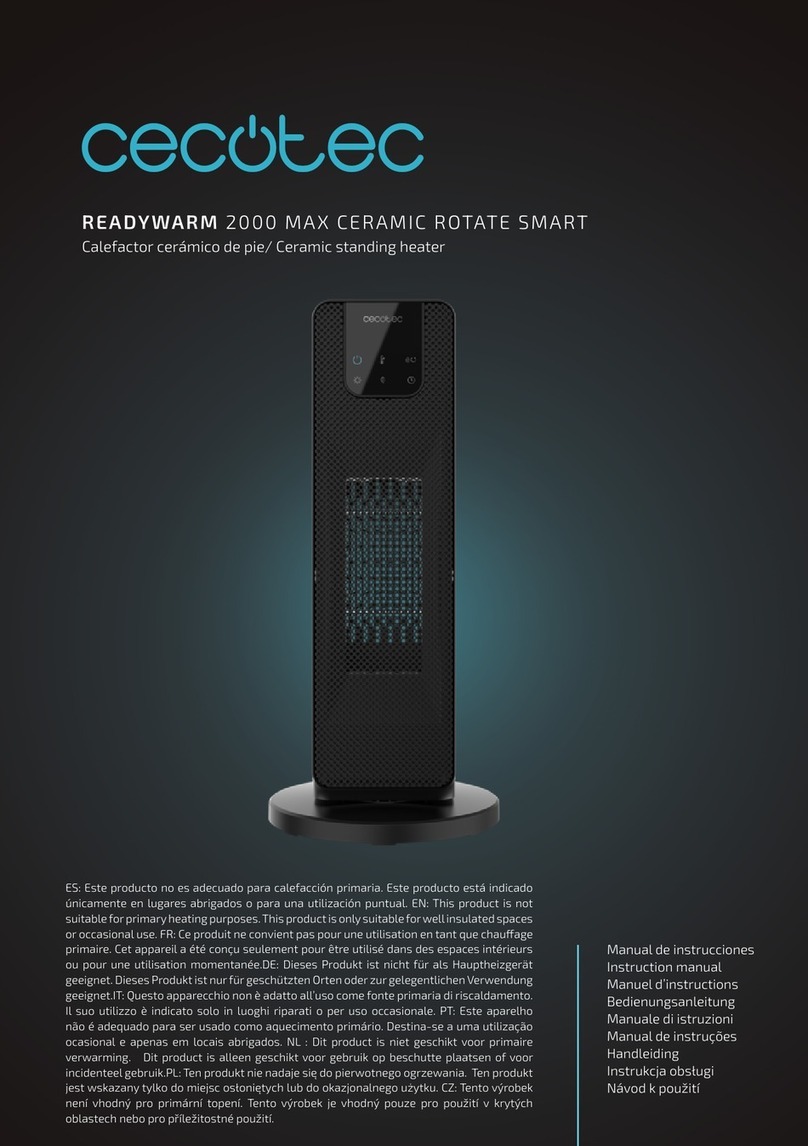
cecotec
cecotec READYWARM 2000 MAX CERAMIC ROTATE DESIGN instruction manual
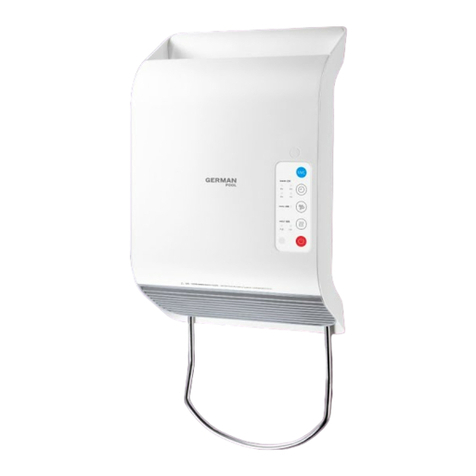
German pool
German pool HTW-330 user manual
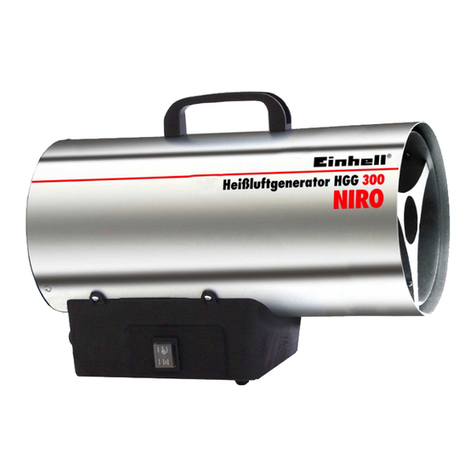
EINHELL
EINHELL HGG 300 Niro operating instructions
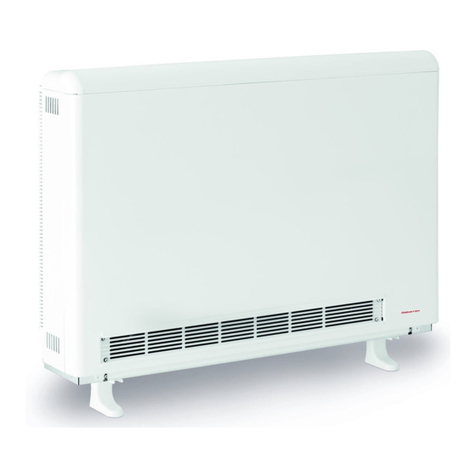
Gabarron
Gabarron Elnur ECOMBI HHR Series installation instructions
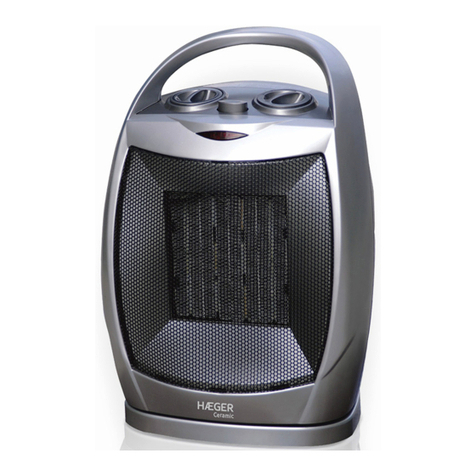
HAEGER
HAEGER FH-15C.012A User instructions

Clarke
Clarke DEVIL 371PC Operating & maintenance instructions
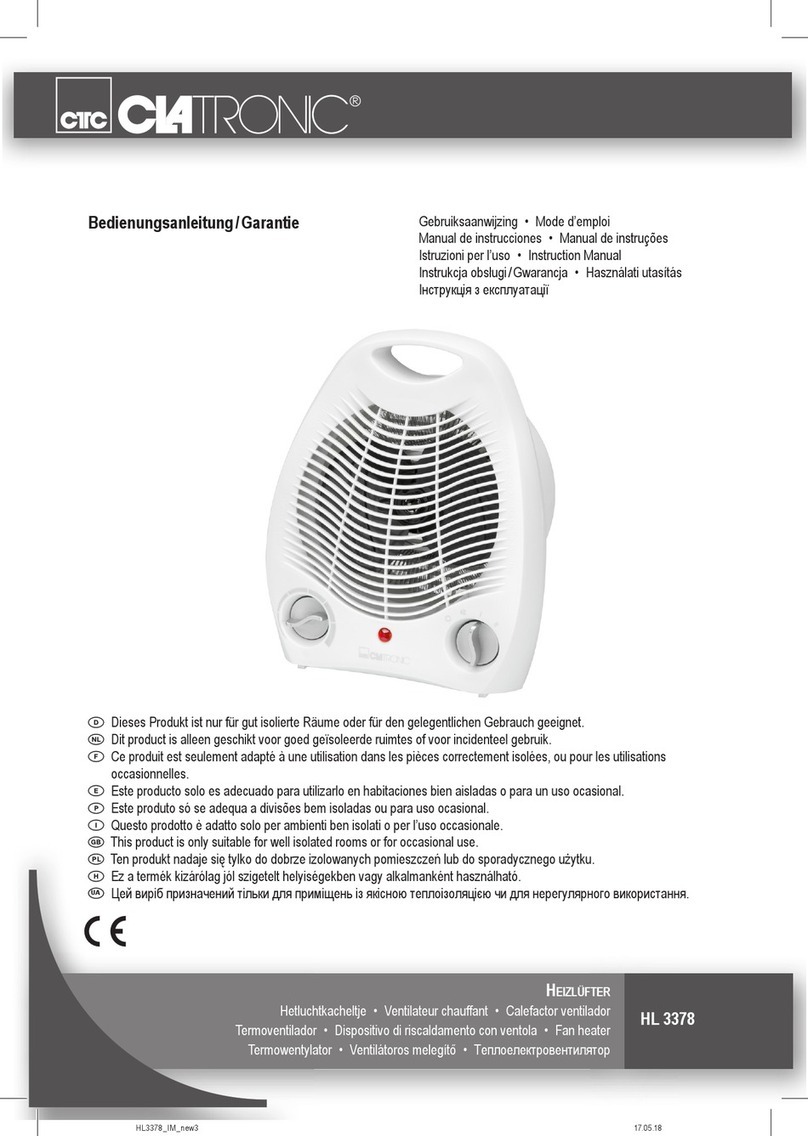
Clatronic
Clatronic HL 3378 instruction manual
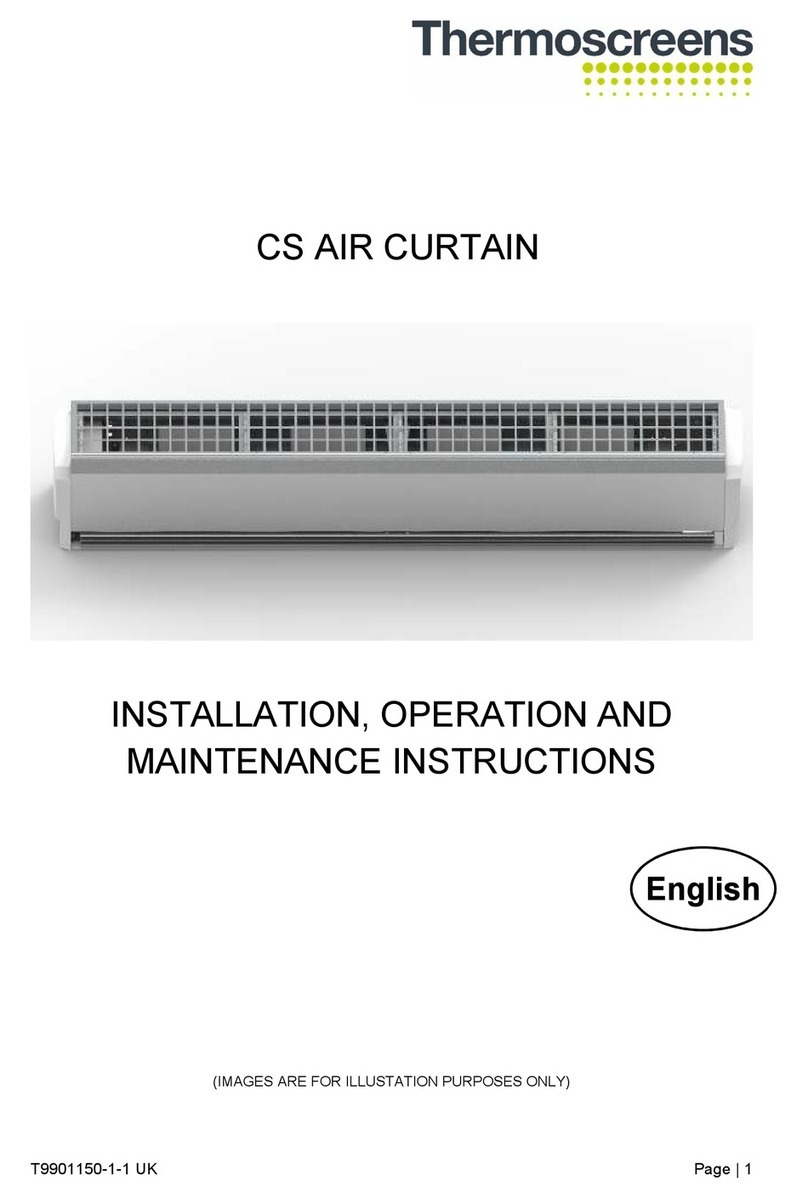
Thermoscreens
Thermoscreens CS 1000 Installation, operation and maintenance instructions

Broan
Broan BHFLED80 instructions
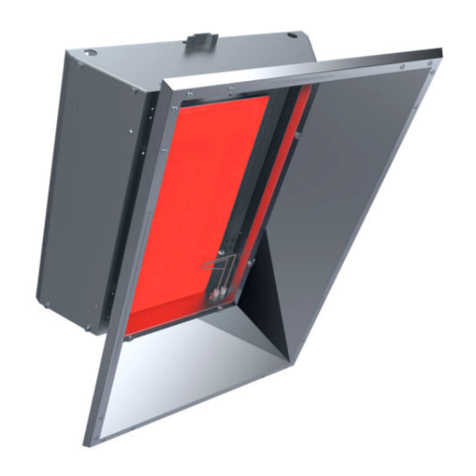
SRP
SRP S Series Installation, operation and service instructions
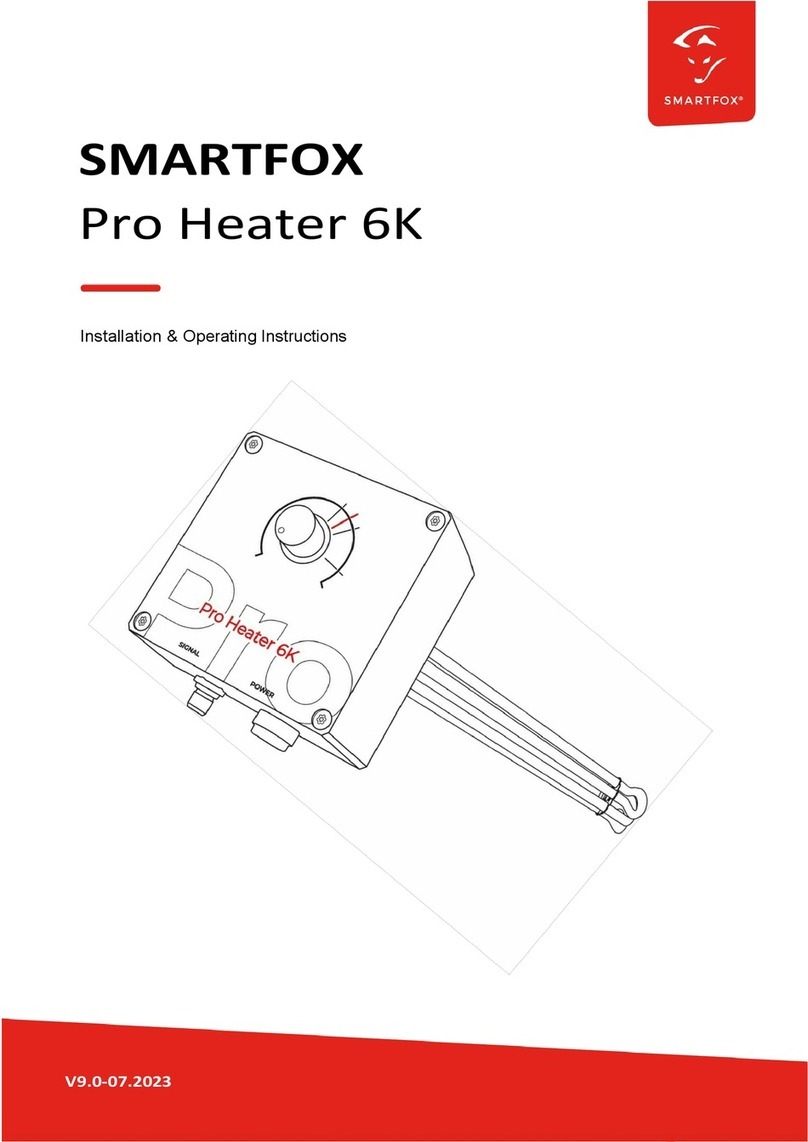
SMARTFOX
SMARTFOX Pro Heater 6K Installation & operating instructions
